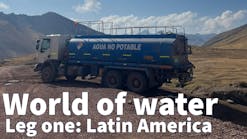Aug. 15, 2002 -- Katherine F. Holt from the state of Virginia received the 2002 Stockholm Junior Water Prize Tuesday from Her Royal Highness Crown Princess Victoria of Sweden during an award ceremony.
Students from 22 countries were participating with water-related projects.
As the Stockholm Junior Water Prize winner, Katherine was presented the coveted blue crystal sculpture and a $5,000 scholarship for her project "Cleaning the Chesapeake Bay with Oysters."
Katherine's project, which won the national-level competition in the U.S. earlier this year, included scientific and business analysis of introducing Asian oysters to clean the water of the Chesapeake Bay near her home in Virginia. Katherine's research looked at how foreign species could be introduced to benefit the Chesapeake while preserving the Bay's native oyster species and meeting national environmental goals. The issue of introducing foreign oysters in the Chesapeake is the subject of current regional debate.
The Australian finalists, a team consisting of Vanessa Megan Hollis, Nathan Sawyer and Andrew James Shaw, received Honorable Mention for their project "Breeding and Releasing Edelia vittata, the Native Western Pygmy Perch." The perch is a threatened species in local waterways, and the students developed an innovative method to breed, introduce and maintain the fish in their school's wetlands.
Forty-five enthusiastic young researchers participated in this year's Stockholm Junior Water Prize competition. They represented Argentina, Australia, Canada, Chile, Denmark, Estonia, Finland, Germany, Israel, Japan, Latvia, Lithuania, Mexico, Nigeria, Norway, Poland, South Africa, Spain, Sweden, United Kingdom, Ukraine and the United States. See the list below for more information about the finalists.
The international Stockholm Junior Water Prize competition has worked to raise awareness and develop scientific, research and analytical skills in young people. The Global Sponsor for the Prize since 1997 has been ITT Industries, and the Sponsor Host Stockholm is Birka Energi AB. The competition in the United States is organized by the Water Environment Federation.
In a signing ceremony before the Prize presentation, officials from ITT Industries, Water Environment Federation, Stockholm International Water Institute and Stockholm Water Foundation welcomed China as the newest Stockholm Junior Water Prize country.
The Stockholm International Water Institute (SIWI), a scientific, technical and educational organization, contributes to international efforts to combat the escalating global water crisis by facilitating research, raising awareness and stimulating action on world water issues. SIWI administers the Stockholm Water Prize, Stockholm Junior Water Prize, Stockholm Water Symposium, Stockholm Water Initiative, Stockholm Industry Water Award and Swedish Baltic Sea Water Award.
The finalists for the Junior Water Prize were as follows:
Argentina: Mercury and Chromium in River: Water and Social Responsibility, by Ainelen Roselina Delgado, Anahi Maria Lovato, Emilce Araceli Mandel, and Maria Teresa Zapata
Australia: Breeding and Releasing Edelia vittata, the Native Western Pygmy Perch, by Vanessa Megan, Hollis Nathan Sawyer and Andrew Leslie James Shaw
Canada: Chironomid Communities as Water Quality Indicators in Trout Lake, North Bay, Ontario, by Richard Miron and Alex Omiccioli
Chile: Cultivation of River Shrimp of the North of Chile, Cryphiops caementarius, Using a Water Recirculation System, by Bruno Alexander Olivares Cortes and Sergio Danilo Julio Galleguillos
Denmark: Cleaning of Waste Water Using a Root Zoning System, by Kenneth E. Ostergaard
Estonia: The River Emajogi and Water Use and Treatment in Tartu, by Timo Uustal
Finland: The Effect of Ammonium Nitrate on the growth of Lemna minor, by Susanne Salovius
Germany: Heavy Metal Accumulation and its Correlation with the External Phosphate Concentration in Lemna minor, a Representative of the Lemnaceae (Duckweed), by Thomas Bottcher
Israel: Contamination of Groundwater in the Coastal Aquifers of Israel, by Gilad Berman and Michael Goldish
Japan: A New and Simple Assay of Endocrine Disrupters, by Takashi Hatano, Mitsutoshi Kumagai and Midori Kumagai
Latvia: Water Pollution in Riga HES Reservoir, by Lauris Klavins and Reinis Vasarietis
Lithuania: The Impact of Minor Hydro Power Stations to the Local Environment, by Jurate Beniusyte, Gintare Eidimtaite and Ugne Meskyte
Mexico: Elaboration of Biosensors for Pollution Detection in the Water of Rivers, by Carolina Jimenez Santillan, Juan Luis Morales Juarez and Felipe Soto Flores
Nigeria: An Investigation of the Causes and Effects of Flooding in the Lagos Area, Nigeria, by Elizabeth Atang, Chigozie Chukwe-Ike and Master Akintunde Sodeke
Norway: Environmental Research of the Stream Unnebergbekk. Is it Also Ending Up in Pipes?, by Magnus Aaroe, Jon Fredrik Hvaal, Kristina Krohn, Hang Phan, and Benedicte Riise Sorensen
Poland: Pollution by Surface Runoff of Water Reservoirs in Warsaw, by Sylwester Janda, Aneta Lipka and Lukasz Slowak
South Africa: A Satellite Dish with a Difference With a Unique Method for Water Conservation from the Bottom of Africa, for Now and the Future, by Antonio Dixon, Zainodeen Isaacs and Tracey-Kim Petersen
Spain: Natural Purification in Torrellas Stream, by Eddie Rodriguez Carballo
Sweden: Measuring Occurrence of Algae with Delayed Fluorescence Excitation Spectroscopy, by Karin Sandberg
United Kingdom: Automated Bathtub, by Geoffrey Jones
Ukraine: Research Radon in Artesian Water in Kiev, by Irina Burdejnaja
USA: Cleaning the Chesapeake Bay with Oysters, by Katherine F. Holt


